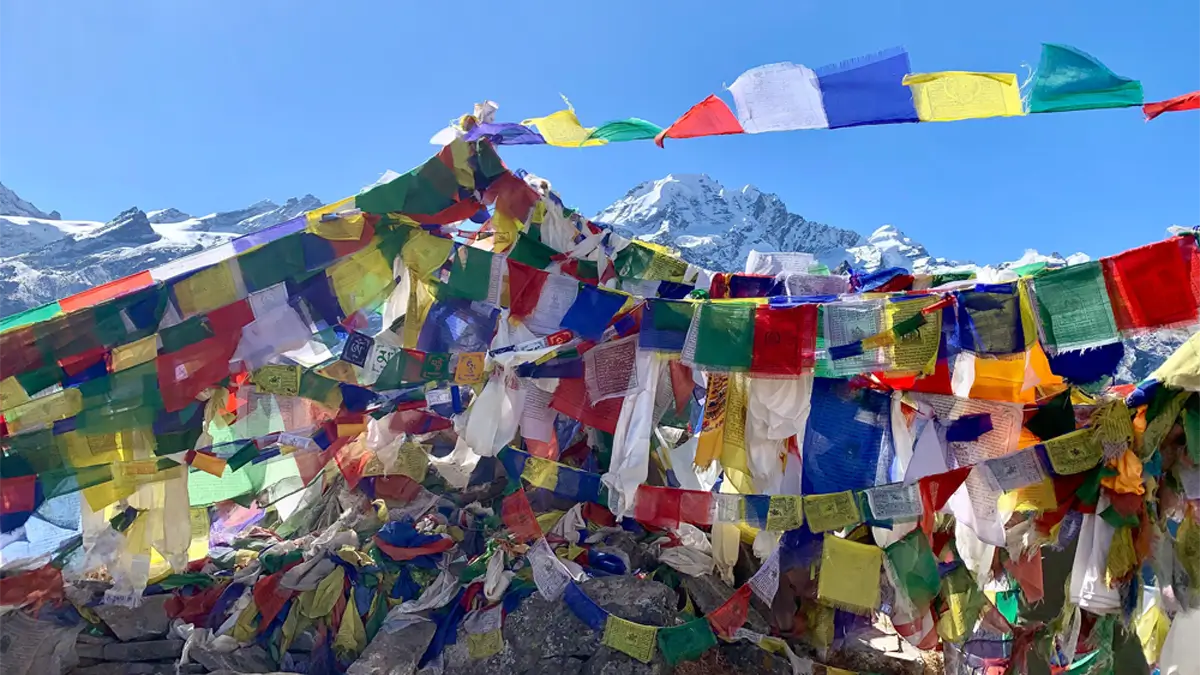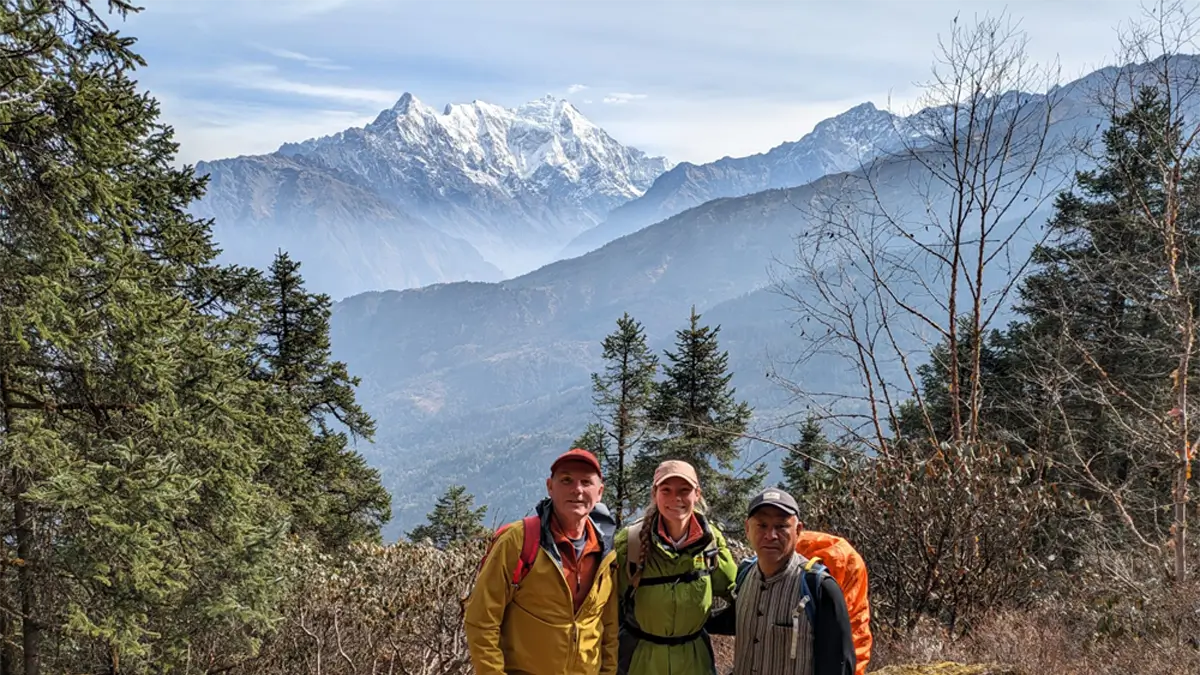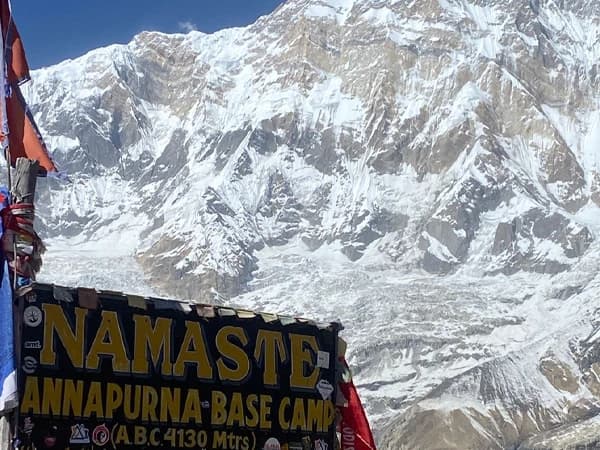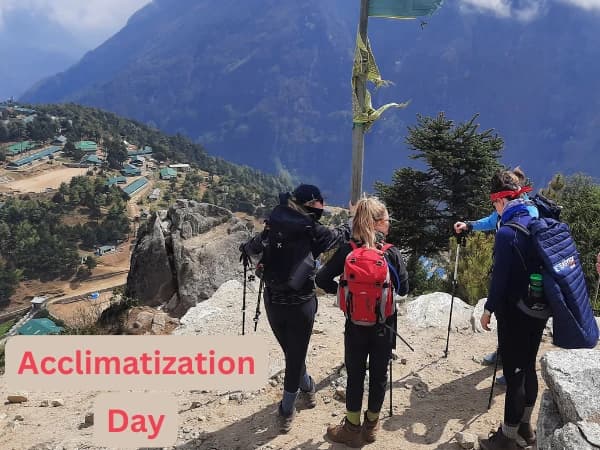Annapurna Base Camp: Throne of the Ice Queens

In the showdown of Annapurna Base Camp vs Langtang Village Trek, Annapurna Base Camp (ABC) grabs attention with diverse, bold, almost cinematic terrain.
Annapurna Base Camp Trek is an unrealistic immersion into one of the most legendary amphitheaters of snow and rock in Earth.
360° walls of snow-capped giants like Annapurna I (8,091m), Machapuchare (6,993m), Hiunchuli (6,441m), Annapurna South (7,219m), Gangapurna (7,455m) Annapurna III (7,555m), flanks so close, as you ascend higher on the mighty trails of Annapurna Base Camp trek.
The Annapurna Base Camp trek is known for its sheer diversity of landscape within a compact timeframe.
You’ll wandering through ancient mountain villages like Chhomrong, Bamboo, hitting up forest hideouts and high-altitude stops like Deurali.
As you push higher, the landscapes changes to cold, raw alpine wilderness. One minute you’re trudging past these ancient rice terraces, then suddenly you’re mossy, rhododendron forests that look straight up-enchanted.
The tricker? You end up in the glacier basin, totally enriched by some of the tallest peaks of Earth.
Wake up early for a sunrise at Poon Hill? Trust me, your camera roll will thank you forever.
And that last stretch to Annapurna Base Camp? It’s like entering a natural amphitheater with 360° panoramic views of snow-capped mountains staring you down from every angle.
Langtang Valley: The Lost Himalayan Kingdom

In the gentle debate of Annapurna Base Camp vs Langtang Village Trek, Langtang enters not with just a roar but a hum. Tucked close to Kathmandu, nestled just a 6-7 hour drive away, Langtang is where Nepal unveils its quiet magic- intimate, untouched and soul-stirring.
In Just a day’s drive from Kathmandu, Langtang Village Trek unveils unrealistic panorama of Langtang Lirung (7,234m), Dorje Lakpa (6,966m), Langsisha Ri (6,412m), Yala Peak (5,520m), Gangchempo (6,378m) and many more, as you ascend higher.
Langtang village Trek begins in Syabrubesi and takes you through an unfiltered, spiritual and human side of the Himalayas.
Unlike the dramatic amphitheater of ABC, Langtang’s landscape is intimate, you will be stumbling into wildflowers meadows and tracing the steps of glaciers that shaped everything ages ago.
The trail winds through epic glacial valleys, think ancient ice carving out the land, glaciers everywhere, pine scented air, alpine meadows, rugged flat kharkas and terrain carved by ancient ice.
You’ll pass through traverse timeless hamlets, like Kyanjin with its old sacred monastery, Langtang’s resilient heart, Ghodatabela where yaks hang out beneath alpine cliffs.
The viewpoint of Langtang valley, Tserko Ri (5,033m) is one of the most underrated Himalayan gems.
If you haul yourself up Tserko Ri, you get a view that’ll have you questioning your life choices, in the best way.
You’ll witness 360° panorama of snow-draped mountains like Langtang Lirung, Langsisha Ri, Gangchempo, Yala Peak, Kimshung, Yubra Himal, Dorje Lakpa including ranges extending into Tibet like Shishapangma and many more from Tserko Ri.
Langtang - Gosaikunda Lake Trek

Gosaikunda Lake Trek is more than a mountain journey; it’s a walk into Nepal’s spiritual heartbeat. If you want to crank up the spiritual dial, tag on the Gosaikunda Lake trek.
Gosaikunda lake is blue as a glacier’s soul and sits up there at 4,360 meters, ringed by legend and icy silence.
Pilgrims believe it was created by Lord Shiva’s trident to quench his thirst after swallowing the poison. Even now, monks, sages and devotees still make that barefoot climb to 4,380 meters during Janai Purnima.
They walk fasting on empty stomach through these high, windswept ridgelines and plateaus.
Gosaikunda sits right in Langtang National Park, surrounded by rugged land shaped by tectonic dramas and carved out by glaciers that were basically throwing a tantrum for centuries.
You start off in Dhunche, ancient mountain village where everyone’s gearing up and slapping on sunscreen. The trail pulls you along old school traditional villages like Chandanbari, Sing Gompa, Laurebina each with its own charm.
As you make your way up to Gosaikunda Lake, the scenary just keeps cranking up the wow factor. Wildflower bursts out everywhere, like nature’s confetti.
The valleys have got the dramatic glacial swagger, as if the ice sclupters were showing off. And then you hit this wind whipped plateaus, steep ridges, whipped plateaus, endless yak pastures, scattered Kharkas.
Honestly, it’s like wandering through some high-altitude fever dream.
Every corner, there’s something new to gawk at. Culture is everywhere: chortens, mane walls, prayer flags dancing in the wind, nature showing off, and you’re right in the middle of it.
The landscape does this wild thing: one second, you’re in these rolling, terraced hills, pine forests whispering all around, then-boom-you’re on this stark, alpine tundra. And then Gosaikunda itself appears, shinning all blue and icy, as a sapphire, tucked under snow-capped monsters.
The entire Gosaikunda Lake is often said to contain 108 lakes. Gosaikunda itself is still, sacred and surrounded by myth. The water is holi, icy and pure. The silence around the lake is not empty but it hums with ancient energy.
From Laurebina Pass, the mountains unfold in a spellbinding panorama. We can witness jaw dropping views of Langtang Lirung (7,227m), Dorje Lakpa (6,966m), Langsisha Ri (6,427m), Annapurna massif, Manaslu (8,163m), the Ganesh Himal range with peaks like Ganesh I (7,422m) all in Gosakunda Lake Trek.
Terrain Showdown: Diversity vs Depth- Annapurna-ABC and Langtang
When it comes to terrain, the Annapurna Base Camp vs Langtang Valley Trek are basically two different beasts. ABC and Langtang valley trek is a battle between sprawling diversity and immersive depth.
Both treks carve through the Himalayas, but how they shape their landscapes, villages, and trail textures are strikingly different.
Both terrains are uniquely Himalayan, but they resonate differently with different hearts.
Annapurna Base Camp (ABC) - For High-Altitude Glory Hunters
The Annapurna Base Camp trail dazzles with ever-shifting landscapes from subtropical forests to icy glaciers within days. Annapurna’s for the thrill-seekers; every day on the trail feels like a new adventure
Every day in ABC feels new. The terrain keeps changing. One moment, you’re in a forest of bamboo and rhododendron, the next, you’re crossing river hanging bridges, walking under waterfalls.
As the trail ascends into the alpine valley, arboreal density decreases significantly with altitude. Prominent snow-capped peaks like Machhapuchhre, Hiunchuli, Annapurna South, Dhaulagiri, and Tent Peak dominate the horizon, their massive forms creating a formidable skyline reminiscent of sentinels.
The segment from MBC to ABC presents a distinctive amphitheater-like terrain, characterized by expansive snowfields and glacial movement down the mountain slopes.
Wind-driven prayer flags mark the area, contributing both visual cues and cultural context to the high-altitude environment. Everything is wide, white and silent.
By the time you finally hit Annapurna base camp at 4,130 m, the whole landscape changes. The tranquil trail transforms into a quiet arena of snow, rock and reverence with unique funky cave and rock formations.
Langtang Valley - Cultural Soul Seekers
Langtang offers fewer dramatic shifts, but more time to immerse in terrain.
Prepare to cross through glacial streams, traverse active yak pastures, kharkas and cross through remote alpine valleys largely untouched by modern development.
Langtang Valley kyanjin Gompa trek initiates at Syabrubesi, functioning as the primary trailhead.
From this point, the route follows the Langtang River, progressing through dense stands of rhododendron and pine, interspersed with sections bordered by narrow cliffs.
Elevation gain results in a transition, where forested zones give way to exposed, rocky pastures.
Langtang village and Kyanjin Gompa are strategically located beneath massive snow-capped giants: Langtang Lirung, Langsisha Ri, Gangchempo, Dorje Lakpa, Kimshung, Yala Peak, and several others.
Here, the terrain is raw. The upper valley is defined by moraines, glaciers, and wind-swept plains, with arboreal vegetation becoming sparse or absent.
This landscape delivers a distinct high-altitude trekking environment, marked by challenging terrain and dramatic alpine vistas.
The upper stretch to Tserko Ri? It’s all surrounded by shiny glaciers, rough moraines, views of alpine valleys and wide-open plains that feels totally ancient.
We can get 360 panoramic views of 9 snow-capped mountains over 6000 meters with ranges extending into Tibet from this magical viewpoint.
The spiritual Langtang Valley Gosaikunda Lake trek is more mystical. Seek blessings at holy, turquoise Gosaikunda Lake created by Hindu God Shiva, get legendary Himalayan views, alpine meadows, profound peace.
You’ll pass ancient mountain villages like Dhunche, Chandanbari and steep climbs to Laurebina.
The trees start to disappear. You walk along narrow mountain ridgelines, snowfields and barren slopes with deep drops on both sides.
The final ascent to Gosaikunda? It’s wild, windblown and raw. Sharp ridgelines drop into deep valleys. Rocky steps twist upward through thinning air.
The trail turns barren with desert like terrain. The horizon stretches wide, stone underfoot, sky above.
Then suddenly Gosaikunda Lake appears, a shimmering mirror tucked beneath snowy ridges, blue and magical.
The Gosaikunda lake is basically a turquoise gem chilling in the arms of these glacier scraped valleys, beneath snow capped giants.
Which Trek is Physically Tougher, Langtang or Annapurna?
Annapurna
Annapurna Base Camp is a longer trek, usually 7-13 days depending on your chosen route and itinerary.
The route features a varied topography, including extended sections of stone staircases, riverside gradients, and sustained high-altitude ascents.
Annapurna Base Camp tops out at 4,130m, but involves longer days and challenging terrain throughout.
The trail of Annapurna passes through ancient valleys and dense, biodiverse forests before the environment transitions to exposed, alpine zones at higher elevations.
Annapurna Base Camp trek requires significant endurance and acclimatization due to both the duration and the demanding nature of the landscape.
Langtang
Langtang Valley Trek Kyanjin Gompa, through shorter- 6-10 days, may go higher if you summit kyanjin Ri (4,774m) or Tserko RI (5,033m).
This makes it Langtang, a practical choice for those seeking high-altitude experiences without the extended time commitment or physical intensity of Annapurna.
In just few days, you rise from lush 1,400 meters to around alpine 3,870 meters with a breathtaking transformation in altitude and scenery.
And if you’re up for the challenge, a side hike to Tserko Ri takes you even higher, to a stunning 5,033 meters above sea level.
Meanwhile, the Langtang Valley Gosaikunda Lake trek is spiritual but it will test your limits too.
Langtang trek commences at Dhunche, serving as the primary starting point. From this location, you’ll proceed along challenging trails and traverse narrow ridgelines.
Ascending to the sacred glacial lake of Gosaikunda, situated at 4,380 meters, demands significant endurance and mental resilience due to the altitude and rugged terrain.
But the experience and unbelievable panoramic views provide substantial rewards for those willing to take on challenge.
What makes Langtang physically tricky is the sudden altitude gain over fewer days. The elevation gain is swift and steep, with sharp altitude gain in just few days.
The trail ascends steadily along the high ridgelines, traversing huge rocky segments, alpine zones, and areas covered in loose stones.
Note: In Annapurna Base Camp vs Langtang Village Trek, Annapurna Base Camp is more intense physically, while Langtang offers elevation with empathy.
Climbing High: Altitude Gain in Langtang vs Annapurna Base Camp (ABC)
Altitude doesn’t test your lungs; it tests your soul. And when it comes to Langtang vs Annapurna Base Camp, the way you gain elevation tells two very different stories.
When comparing Langtang valley to Annapurna Base Camp (ABC), the climb through elevation is a story of contrast.
Annapurna Base Camp: A Gradual Ascent Through Shifting Worlds
The trek to Annapurna Base Camp (ABC) starts low at Nayapul (1,070m). The trail climbs gently through high rolling mid hills, rice terraces and lush forested paths.
You gain altitude slowly, giving your body time to adjust. Every day you rise just enough to feel it. The ascent is measured, never abrupt.
Starting at Nayapul, you progress through traditional mountain villages like Chhomrong (2,170m), then Deurali (3,230m).
The trail design lets you acclimate incrementally. You’re not suddenly thrust into high altitude; your physiology gets a chance to adapt as the altitude increases and the terrain shifts.
The approach to Annapurna Base Camp (4,130m) is systematic. There’s no abrupt transition. Instead, elevation gain is distributed evenly, minimizing the risk of acute mountain sickness.
It’s a controlled ascent, your body adjusts as you move, making the journey to ABC efficient and, frankly, a lot less stressful on your system.
The gain feels natural, no sharp jumps, no sudden shocks. It’s a steady walk into the heart of the Himalayas.
While the ultimate destination is Annapurna Base Camp, if you begin experiencing issues with the altitude there is a practical alternative: to rest at beautiful Machapuchare Base Camp. Machapuchare Base Camp, located at 3,700 meters is approx. 430 meters lower than ABC.
MBC functions as a reliable staging point, offering shelter and necessary warmth, in addition to unobstructed views of prominent Himalayan peaks such as Annapurna I, Annapurna South, Hiunchuli, Gangapurna, Tent Peak, and Singha Chuli, among others.
The location allows trekkers to appreciate the surreal alpine landscape without exceeding and pushing your limits.
Furthermore, MBC also serves as an effective acclimatization site, enabling individuals to rest and gradually adjust to higher altitudes before advancing to Annapurna Base Camp (ABC).
This approach reduces the risk of altitude-related complications and supports overall expedition safety.
Langtang: Straight into the sky, Quick altitude gain
Langtang on the other hand, offers not just one, but multiple summits to celebrate.
The trail starts at Syabrubesi (1,550m) and soars fast. By four days into the trek, you’re already above 3430m.
The classic Langtang Kyanjin Gompa route is a remarkably swift ascent. Starting from Syabrubesi at 1,550 meters, trekkers find themselves at Kyanjin Ri, soaring at 4,773 meters, in just a matter of days.
The climb is steep, challenging yet energizing. Trek to Langtang covers elevated ridgelines, rugged cave formations, alpine environments, snowy expanses and landscapes with panoramic views of snow-draped monsters.
And if you push to Tserko Ri (5,033m), you’ll find yourself standing above the clouds, wrapped in silence and snow-lit skies.
Then comes the magic of the Gosaikunda lake trek. Another trail, another challenge. You start your trek at Dhunche (2,030m), but within days you’re touching the holy crystal clear waters of Gosaikunda (4,380m).
Go a little higher and you’ll cross Laurebina La Pass (4,610m), a place of endless views and open skies.
The elevation gain here is thrilling. To the north, the peaks of LAngtnag Lrung, Manaslu and even glimpses of distant Tibetan ranges shimmer in silence. Behind you, Gosaikunda lake glisten like scattered sapphires.
Culture Unfiltered: Museum vs Living Memory
In Annapurna, you walk through cultural layers- ancient Gurung villages, apple orchards, Buddhist stupas, Mane wheels, chortens. It’s like flipping through Nepal’s scrapbook. Everything is documented, preserved and presented.
The Gurung community in Annapurna is proud and welcoming. Annapurna offers curated authenticity- accessible, beautiful and slightly tailored for comfort.
But in Langtang, culture isn’t curated- it lives and breathes beside you. Here, prayer wheels spin beneath glacier winds, an homes are built with hand-stacked stones. Tamang homes welcome you not like only trekker but like part of their own family.
The Tamang culture in Langtang thrives in raw and unpolished form. The resilience after the 2015 earthquake hasn’t modernized the region, it has deepened its spirit. Langtang delivers raw cultural immersion where heritage is lived, not displayed.
Accessibility and Affordability: About Annapurna VS Langtang
Langtang Trek
Langtang is closer. Just a 6-7 hours scenic drive from Kathmandu drops you at the trailhead, and you are already walking into the wild.
The trek includes no flights, no long transits. It’s straightforward, time-saving and spontaneous travelers love it.
Affordability? Langtang is lighter on your wallet. Fewer days, no flights and close proximity keeps cost low. Tea houses are budget friendly yet heartwarming in hospitality.
ABC- Annapurna
Annapurna, depending on your route, may involve flights, buses, permits and more logistics. But it also stretches the journey- more days, more diversity, more trekking legend made chat.
Annapurna Base Camp, while not overly expensive, does cost more. More days, longer logistics and varied altitude mean a bit more on transport, food and permits.
Note: If you’re chasing a high return on a modest budget and time, Langtang sings your tune. For those seeking a longer adventure with layered landscapes, Annapurna rewards the extra spend.
Trekking Tea Houses, Temples and Timeless Trails
In the immersive journey of Annapurna base camp vs Langtang village trek, the tea houses, sacred sites and rugged trail reflects the soul of each region.
Both routes carry centuries of prayer, pain, pilgrimage and pride. But their trails, tea houses and temples speak different dialects of the Himalayas. One whispers, one roars. You decide which speaks to your soul.
Annapurna Base Camp (ABC)
Annapurna Base Camp trek starts from Nayapul (1,070m).
The trail climbs through ancient Gurung and Magar settlements of Ghandruk, Chhomrong, Sinuwa, Deurali and up to Machhapuchhre Base Camp, before finally reaching Annapurna Base Camp at 4,130m.
Tea houses in Annapurna are cozy, warm and full of charm with wooden interiors, thick blankets, fire-lit dinning halls and big glass windows that capture Annapurna South, Hiunchuli, Annapurna I, Gangapurna like a live living gallery.
Plastic bottles and plastics are banned in Annapurna base camp trek from Chhomrong. You won’t find tea house selling mineral water bottle, so you have to carry your own bottle.
The Annapurna trail whispers of Gurung traditions and Hindu-Buddhist harmony.
We’ll journey through prayer wheels in Chhomrong, hear monks chant in Jhinu Danda and feel the spiritual weight of sacred, unclimbed Machhapuchhre peak- reverbed by locals as the home of Hindu God, Shiva.
Jhinu’s hot spring, by the Modi Khola also feels like nature’s temple. The hot spring of Jhinu Danda feel like a holy dip for tired souls, after days of trekking.
The ABC trail is a mosaic, through some rice terraces, rhododendron forests, high ridgelines and glacial moraines.
You’ll cross suspension bridge over roaring rivers, cobbled village paths passed down for generations, stone staircases that feel carved by the hands of time.
Langtang Trek
The Langtang- Kyanjin Gompa Trek starts from Syabrubesi (1,460m). The Langtang trek gradually rises through Lama Hotel (2,470m), Langtang village (3,430m) and finally Kyanjin Gompa (3,870m)- the spiritual crown of the valley.
Langtang is drenched in Tibetan-Buddhist energy. prayer flags flutter like prayers written in color.
The path follows the Langtang river, past rhododendron forests, rocky ravines and alpine meadows guarded by snowy peaks.
Langtang’s tea houses are simple. Often family run, they serve fresh yak cheese, butter tea and traditional meals prepared with love. You’ll find Traditional Tibetan décor, stone and wood-built lodges, locally sourced meals, peace and genuine warmth.
Langtang’s tea houses feel rawer. Built after the 2015 earthquake with love and resilience, many are family owned and operated. Along the trail, you’ll see mani walls, ancient chortens and monks spinning prayer wheels.
The crown jewel? Kyanjin Gompa- a 400 year old monastery resting beneath snow-capped giants and silence. You can feel high level of energy inside Kyanjin Gompa, which is a natural energy vortex.
If you’re trekking to Gosaikunda, your journey begins from Dhunche (2,030m) and climbs through Sing Gompa, Laurebina, before reaching the holy sapphire blue lake at 4,380m.
Gosaikunda, believed to have created by Shiva’s trident, holds 108 glacier-fed lakes.
This holy lake is the spiritual Himalayan hotspot of Langtang region. During Janai Purnima, hundreds of pilgrims hike to 4,380 meters barefoot, with empty stomach, chanting prayers with every step.
Annapurna: A Village in Every Bend
The Annapurna trail is a parade of Himalayan Hospitality. Annapurna doesn’t just show you mountains, but invites you into homes. The Gurung and Magar culture is woven into the trek.
Each day you wander through ancient stone villages, Ghandruk, Chhomrong, Sinuwa, where the trail is lined with blooming rhododendron, fluttering prayer flags beneath snow-capped giants.
Every few hours, a tea house appears like an oasis. Stone-paved paths lead you through Gurung and Magar villages.
Each settlement greets you with a smile. The tea house here feels lived in, welcoming, and woven into the trail’s soul.
Temples and Gompas dot the path like ancient bookmarks. Small, sacred and often hidden behind mossy trees, beside waterfalls, stone trails, inside courtyards.
Langtang: Temples in the Mist
Langtang is not just a trek, it’s a pilgrimage wrapped in silence.
Trails pass ancient stone chortens, mani walls and Buddhist shrines that predate even the oldest tea houses. You’ll walk alongside mani walls, cross bridges wrapped in prayer flags.
Monks pass you on the trail with prayer beads in hand. Yaks graze on the mist-covered hills beneath snowy, towering peaks.
As you climb through shaded forests and riverbanks, the trail gently introduces you to Lama Hotel, Langtang village, and eventually Kyanjin Gompa - a high-altitude hamlet framed by glaciers and prayer stones.
In Langtang tea houses are fewer, but deeper in meaning.
The tea houses here feel more remote, more rustic as they offer something rare and rawness. Built of stone, warmed by yak dung fires, and watched over by monks in maroon robes
FAQs: Annapurna Base Camp vs Langtang Valley Trek
Is Langtang Easier to Reach Than Anapurna Base Camp?
well, both are similar moderate trek routes. Langtang starts with a scenic 6-7 hrs drive from Kathmandu to Syabrubesi. no flight or extra transfer needed.
Annapurna base camp requires reaching Pokhara first, either by flight 25-30 minutes or long drive (6-7 hrs) followed by a road transfer to the trailhead at Nayapul.
Which Trek Has More Diverse Landscapes?
Annapurna Base Camp trek offers more diverse landscapes.
3. Which Trek is Cheaper for Budget Travelers?
The prices are similar for both trekking, and the cost will be different depending on the required services and the duration.
Are Tea Houses Better on the Langtang Route or Annapurna?
Nowadays, both the langtang trekking routes and the Annapurna are developed, but still, some of the accommodation are basic. Especially in the ABC-Annapurna Base Camp.
Which Trek Offers a Deeper Spiritual and Cultural Vibe?
Langtang is deeply woven with Tibetan Buddhist culture. ABC passes through mountain vistas, Gurung and Magar villages, rich in tradition but less spiritually immersive than Langtang’s Kyanjin Gompa’s region.
Can I Trek Both in One Trip?
Yes, you can do both treks, but it is good to do the first one, the Poon Hill route to the ABC-Annapurna Base Camp, and then Langtang village trek.
What Gear do I Need That’s Different for Each Trek?
Highly recommend well trekking gear for both the annapurna base camp and langtang village trek.
Trekking gear is preety similar for both trekking routes. Well, you can also ask your Nepal trekking operator about trekking gear. And read more here for information.
Which Trek is Easier to Descend and Safer Regarding Altitude Sickness Risk?
Smoother altitude profile and acclimatization on ABC makes it slightly safer. Langtang reaches higher quickly, specially Gosaikunda and Tserko Ri, so more vigilance is needed.
Which Trek is Safer During the Winter Months?
Well, both trekking routes are safe, as long as you have the right equipment and a strong mentality with a good experience trekking guide.
Which Trek has Fewer Crowds?
The Langtang trek is less crowded and more tranquil. But nowadays, everywhere people are.
Can I Trek solo?
Yes, you can do solo trek, but we recommend that you hire a guide or porter (optional)







